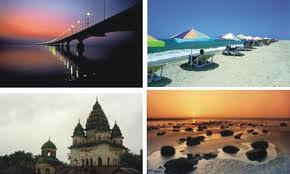Abstract
Bangladesh is a land of scenic beauty. The country is blessed with natural beauty which attracts the tourists. It has beautiful beaches as well as the longest beach in the world. It is proud of its beautiful heritage and historical relics. To make best use of the natural gift, the country has developed facilities of modern hotels, motels, rest houses, youth inns and restaurants, well modern modes of communication, are available at all tourist attractions.
Now for the globalization facility the scope of tourism industry is increasing. That is also a better way of generating sustainable GDP for Bangladesh. The contribution of Travel & Tourism to Gross Domestic Product is expected to stay the same at 5.6% in 2009-2012 AND GDP growth for Travel & Tourism economy is expected to be 5.78% in current situation. Export earnings from international visitors and tourism goods are expected to generate 5.78% of total exports in 2009-2012.
Introduction
This study builds on the current campaign for tourism industry study based on service industry in Bangladesh. In brief, the study seeks to flesh out the objective and substantive basis for the reform movement and the needed reform measures to build a world class tourism industry with providing perfect service to tourists.
Tourism in Bangladesh is a slowly developing foreign currency earner. The country has much to attract international and domestic tourists.
Bangladesh’s tourist attractions include archaeological sites, historical mosques and monuments, resorts, beaches, picnic spots, forests and tribal people, wildlife of various species. Bangladesh offers ample opportunities to tourists for angling, water skiing, river cruising, hiking, rowing, yachting, sea bathing as well as bringing one in close touch with pristine nature. Lonely Planet ranked Bangladesh as the best value destination for the year 2011.
In the northern part, comprising the Rajshahi division, there are archaeological sites, including the temple city Puthia in Rajshahi; the largest and most ancient archaeological site, Mahasthangarh in Bogra; the single largest Buddhist monastery, Paharpur in Naogaon; the most ornamental terracota Hindu temple in Bangladesh Kantaji Temple, and many rajbaris or palaces of old zamindars.
In the south-western part, mainly the Khulna Division, there is the Sundarbans, the largest mangrove forest of the world with Royal Bengal Tiger andspotted deer. The historically and architecturally important sixty domed mosque in Bagerhat is a notable site.
In the south-eastern part, which is the Chittagong division, there are natural and hilly areas like Chittagong Hill Tracts, along with sandy sea beaches. The most notable beach, in Cox’s Bazaar, is a contender for the title of longest unbroken sandy sea beach in the world.
In the north-eastern part, Sylhet division, there is a green carpet of tea plants on small hillocks. Natural reserved forests are great attractions. Migratory birds in winter, particularly in the haor areas, are also very attractive in this area.
In 2004, the US Department of State estimated the daily cost of staying in Dhaka at $191.
Also a brief recommendation of my rationalization findings has been presented for further consideration of tourism industry perspective. I hope my effort will be highly appreciated by the service industry in Bangladesh.
Objectives & Scope
This is not believe, it is actually true that through Eco tourism, tourism industry can play an important role to safe guard our natural resources and sustain the ecological process of the nature which should also be the ultimate motto of modern tourism. Eco tourism is a new concept of the present millennium. The important role of Eco tourism is to try to combine the conservation of unique local resources such as nature, history and culture with the establishment of tourism industry and the activation of local communities.
Day by day the importance of Bangladesh is increasing among foreigners as a charming tourist country. That is why market of tourism industry is expanding in current situation. Actually the main purpose of this report is to justify and also analyze data, facts & information of tourism industry of Bangladesh, because of focusing the potential and less-potential sides of this sector.
Methodology:
The preparation of the possibility study of “Tourism Industry” involves the following steps:
- At first I identified or collected secondary data or information about tourism industry of Bangladesh.
- Next I developed information to figure out the findings.
- Then given some recommendations according to analysis (findings).
Limitations
Preparation of feasibility study of farm involves a number of limitations in its various stages. While preparing the project paper I faced the following problems which I tried at my level best to avoid:
- Collection of data is a hard job in this stage of project, because many farms are not interested to provide their information as well.
- The arrangements of package & price are tough task for client satisfaction.
- It is difficult to estimate and do all the financial projections accurately according to the current market.
Some tourist places in Bangladesh
Cox’s Bazaar:
Miles of golden sands, towering cliffs, surfing waves, rare conch shells, colorful pagodas, Buddhist temples and tribes, delightful sea-food–this is Cox’s Bazaar, the tourist capital of Bangladesh. Having the world’s longest (120 kilometers.) beach sloping gently down to the blue waters of the Bay of Bengal, Cox’s Bazaar is one of the most attractive tourist sport in the country. There are also a few very old wooden Buddhist temples at Ramu, a few kilometers from Cox’s Bazaar, well worth visiting. Located at a distance of 152 km. south of
Chittagong, the leading seaport of Bangladesh, Cox’s Bazaar is connected both by air and road from Dhaka and Chittagong. A drive to Teknaf, which is the southernmost tip of the mainland of Bangladesh, is a memorable journey. A day trip to either Moheshkhali or Sonadia, the deltaic islands nestled among the gentle waves of the Bay of Bengal, will also be really interesting. Other attractions for visitors are conch shell market, tribal handicraft, salt and prawn cultivation. Besides, the longest sea-beach, Cox’s Bazaar and its adjoin areas have a lot of things to see and places deserve visit by the tourists.
Shundarban:
The Sundarbans, the largest mangrove forest of the world is a cluster of islands spanning over 10,000 sq. km. Out of which 6017 sq. km. within Bangladesh territory and further extended for another 3983 sq. km. Into Indian territory. ‘Subdarbans’ meaning beautiful forest offer splendid wildlife habitat supporting 333 species of plant, 400 spices of fishes and 425 species of wildlife among of which 49 species mammals, 315 bird species, 53 reptiles and 8 amphibians. The larger terrestrial mammals are Royal Bengal Tiger, spotted deer, Rhesus macaque and Indian smooth otter.
The giant salt-water crocodiles, Rock Python, Monitor lizards and king cobra are the prominent species of reptile group. Considering the great value of Sundarbans it has become now the part of world heritage area that is equally important to the nature loving tourists. So the journey to this wonderful jungle will be very much rewarding to know the unknown. This unsurpassed jungle is only accessible by boat. The most attractive wildlife sanctuary and eco-tourism spots of Sundarbans: Katka, Kachikhali, Tiger Point, Egg Island, Dubla Beach, Hiron Point, Tinkona, Mandarbaria, Kalirchair, Pushpakathi
Wild life photography by still camera/filming- video/documentary/TV media. Experience with exciting fishing by trained otter inside the narrow canal. Meet the nomadic fisherman-woodcutter-honey collectors, who are still on their primitive life style and culture. Rare birds commonly seen: Masked fin foot, Adjutant stork, White bellied Sea Eagle, Kite Kingfisher, Waders & Shore birds.
St. Martins Island:
This small coral island about 10km (6mi) southwest of the southern tip of the mainland is a tropical cliché, with beaches fringed with coconut palms and bountiful marine life. There’s nothing more strenuous to do here than soak up the rays, but it’s a clean and peaceful place without even a mosquito to disrupt your serenity. It’s possible to walk around the island in a day because it measures only 8 sq km (3 sq mi), shrinking to about 5 sq km (2 sq mi) during high tide.
Most of island’s 5500 inhabitants live primarily from fishing, and between October and April fisher people from neighboring areas bring their catch to the island’s temporary wholesale market. A ferry leaves Teknaf for St Martin every day and takes around 3 hours. Getting to St. Martin’s is a three-step program. First you’ll need to fly or bus it down to Cox’s Bazaar, and then catch a bus to Teknaf, which is right on the very tip of Bangladesh.
Maheskhali:
An island off the coast of Cox’s Bazaar. It has an area of 268 square kilometers. Through the center of the island and along the eastern coast line rises a range of low hills, 300 feet high; but the coast to the west and north is a low-lying treat, fringed by mangrove jungle. In the hills on the coast is built the shrine of Adinath, dedicated to Siva.
Bandarban:
The Bandarban hill district is 92-km distance from Chittagong and is situated in the southwest flank of Myanmar hill range. This is the most attractive place to visit and to get a touch of tribal life, luminous valley covered with dense forest, enchanting spring and falls, panoramic lake and ideal for hill tracking. Here you will see the Moorang tribal villages, traditional markets and Buddhist Temple. In an ecotourist lodge you will enjoy an overwhelming scenic surroundings and natural setup during your stay in the cottage. Visit Shaila Prepat and Chimbook Hill. Trekking to the hilltop (3800 feet high pick) has got a spectacular natural attraction attraction specially to witness the sunrise and sunset will give you a sensational experience.
Paharpur:
The biggest Buddhist monastery in the south of Himalayas having gigantic pyramidal temple with 177 monastic cells and numerous votive stupas lays at Paharpur a picturesque village of Jamalganj under greater Rajshahi district. The Paharpur Museum has got the rich collection of a terracotta plaque, images of different gods & goddesses including the Buddhist status, relics, copper plates and other objects.
Mohasthangarh:
Mohasthangarh is invariably an ancient fortified city acclaimed to be the oldest settlement and the most prominent archaeological site of Bangladesh. The oldest layer dates back to 300 B.C. The ancient Pundranagara, the capital of Emperor Chandragupta, the founder of Moyura dynasty was located here and became ‘great place’ during 322-298 BC. The fourth one goes to the Islamic Middle Age from 15th to 16th century AD. The rich archaeological museum of Mohasthangarh have got rare collection of antiquities, terracotta objects with many other relics recovered from the site. This 7th century archaeological heritage contains not less than 63 stone images and about 3000 beautiful terra-cota plaques originating many Buddhist religion and Hindu epics.
Situational analysis
Current Scenario in Bangladesh:
Gross Domestic Product (GDP):
The contribution of Travel & Tourism to Gross Domestic Product is expected to stay the same at 5.6% (BDT465.8 bn or US$7690.3 mn) in 2009-2012 to 5.6% (BDT1412.3 bn or US$15978.96 mn) by 2016.
Growth:
Real GDP growth for Travel & Tourism economy is expected to be 5.78% in current situation and to average 8.64% per annum over the coming 3-5 years.
Exports:
Export earnings from international visitors and tourism goods are expected to generate 5.78% of total exports (BDT63.5 bn or US$986.8 mn) in 2009-2012, growing (nominal terms) to BDT134.5 bn or US$1,473.4 mn (3.5%) of total in 2019.
World Ranking:
The Bangladesh Travel & Tourism economy is ranked number:
84 in absolute size worldwide
172 in relative contribution to national economies
29 in long-term (10-year) growth
The principal channel of Government involvement in the tourism sector is the national tourism organization, Bangladesh Parjatan Corporation, which is a semi autonomous government agency reporting to the Ministry of civil Aviation and Tourism as its administrative Ministry. Many of BPC’s managerial matters are handling through the national Tourism Facilitation committee headed by the secretary of the ministry of Aviation and Tourism.
BPC was created on the 27th November 1972 by order of the Government of the People’s Republic of Bangladesh and commenced business in January 1973. It was established as a Corporation under the laws of the country with an authorized capital of Tk one core (roughly US$ 1.3 million then) and initial share capital of Tk five lakhs (roughly US$ 65,000 then).
Government Investment in Tourism
(A) Government investment in BPC:
The latest available at the time of preparation of the master plan report shows total government investment of over Tk. 20 crore. That amount, equivalent to us$ 6.7 million was composed of fully paid capital of Tk 345 lakhs (us$ 1.15 million), grants Tk 281 lakhs (us$ 0.93 million), and loans Tk 14.4 crore (us$ 4.82 million). Of the total investment at the balance sheet date, net assets account for Tk 13.9 crore (us$ 4.62 million) and operating losses (including depreciation) for Tk 9.2 crore (us$ 3.07 million).
(B) Government investment in Biman Bangladesh airlines:
Substantial levels of investment have taken place both in Biman and in the rehabilitation and development of domestic airports. In TFYP, for example an allocation is made to Biman of Tk 140 crore (us$ 47 million), and to domestic airport development to Tk 70 crore (us$ 23 million), for improvements at Sylhet and Chittagong and for further capital works at Zia international Airport in Dhaka.
Private Investment in Tourism:
The tourism sector receives significant loan finance from the commercial banks. The starting date for the period of income tax exemption for companies in the tourism sector has been extended to June 1990. The period of exemption varies with the district in which the activity is arrived on and portions of the profits must be reinvested in the activity or in government bonds. Recent private sector investment initiatives appear limited to Dhaka, however. The primary reasons for this would appear to be demand deficiency rather than any institutional constraints. One of the examples of private investment in tourism is Fantasy Kingdom. Besides the Dream Holiday Park is another new attractive visiting place, that opened last year.
Problems and constraints regarding tourism industry
Infrastructure development and the resources required for that purpose aremajor problems standing in the way of tourism development. Planneddevelopment of the tourist product is partly dependent on the socio-economicconditions of the country, and this is problem as well. Marketing of Bangladeshtourism abroad faces constraints created by inadequate funds and lack of knowledge.The Bangladesh government and the Bangladesh Aid Group have takenseriously the idea that Bangladesh is the test case for development. In the late1980s, it was possible to say, in the somewhat patronizing tone sometimesadopted by representatives of donor organizations, that Bangladesh hadgenerally been a “good performer.” Even in straitened times for theindustrialized countries, Bangladesh remained a favored country for substantialcommitments of new aid resources from a strikingly broad range of donors. Thetotal estimated disbursement for FY 1988 was estimated at US$1.7 billion, animpressive total but just US$16 per capita. Half of that total was for food aidand other commodities of limited significance for economic growth. Even withthe greatest imaginable efficiency in planning and administration, resource-poor and overpopulated Bangladesh cannot achieve significant economicimprovements on the basis of that level of assistance.Problems in brief Despite occasional meetings and adoption of plans of
Lack of transport links (air, rail, road and sea transport connecting major tourist destinations).
Lack of sincerity and political will to promote Bangladesh as a commontourism destination: This emanates due to competition between thecountries for tourists, given that all of the countries offer somewhatsimilar tourist products and compete in the same markets in the world.
There has been a lack of funds and technical expertise. The little seedmoney that the Bangladesh Tourism Fund has been established with can pump prime the initial take-off, with publication of promotional materialsand familiarization tours.
Absence of effective coordination: This stands in the way of effectivecoordination among the relevant departments, agencies and ministries inBangladesh.
Government tax on hotel accommodation and food facility inBangladesh is also not adequate. An ADB report points out that “Hotelrates in Dhaka are high compared to neighboring countries, reflecting thehigh taxation imposed on hotels in Bangladesh.”Lack of government policy is also a problem for tourism industry. Thisindicates that our tourism is in a problem of proper guide line.Corruption: Corruption is one of the major problems regarding tourismindustry in Bangladesh. For that some foreign tourist fell into problem intheir smooth and continue journey in Bangladesh.
PROSPECTS
In examining the economy of Bangladesh, wherever one turns the problemscrowd in and threaten to overwhelm the analysis. Underlying problems thathave threatened the young nation remain unsolved. These problems includeoverpopulation and inadequate nutrition, health, and education resources; a lowstandard of living, land scarcity, and vulnerability to natural disaster; virtualabsence of valuable metals; and inadequate government and bureaucraticstructures. Yet the brief history of independent Bangladesh offers much that isencouraging and satisfying. The World Bank, leader of the Bangladesh AidGroup, described the country in 1987 as a success story for economicdevelopment and expressed optimism that the goals of the Third Five-Year Plan, and longer term development goals as well, could be attained.
The picture of day-to-day and even year-to-year performance of the economy of Bangladesh is a mixture of accomplishment and failure, not significantlydifferent from that of the majority of poor Third World countries. Thegovernment and people of Bangladesh are entitled to take some pride in thedegree of success they have achieved since independence, especially when onecontrasts their success with the gloomy forecasts of economists andinternational experts. The international donor community, led by the WorldBank, similarly can be proud of the role it has played in assisting this “largest poorest” nation to become a respected member of the family of nations.Some other prospects1.Tourism industry may be turned into the major source of earning foreigncurrency for Bangladesh.
2. It has the ability to introduce Bangladesh with the people around theworld.
3.Tourism industry can also help us to create a better image in the world.
4.It can also help Bangladesh in business purpose.
5.Bangladesh has a large number of tourist spot in its area. All of them arespecial in their own character. So all of them have individual attractionfor the tourist if some contractual work is done for easier movement.
6.These tourist spots also can eliminate the unemployment problem of Bangladesh. Specialist said that more than 30% employment could beincreased if the government takes proper step for the development of tourism areas.
7.The government of Bangladesh can earn a huge amount of revenue fromthis sector which can help Bangladesh to establish a healthy economiccondition.
8.If we can make a position in the 7 wonders through Cox’s Bazar andSundarbans then the prospects of tourism industry in Bangladesh will behigher and higher.
9.As a third world country in the world Bangladesh can promote its position through the proper utilization of tourism industry.
10.Thus the overall condition can be improved by proper utilization of tourism sector.Reams of paper have gone into writing about the prospect of tourism inBangladesh in all the mediums of reporting. For the last three decades, we have been endeavoring to develop tourism, but the expectations have not always beenmet. The good news is that many high officials concerned with nationaldevelopment have recently come to understand the importance of tourism
SWOT Analysis:
SWOT stands for Strength, Weakness, and Opportunity & Threats. So SWOT analysis of tourism industry is given below:
Strength:
- World’s longest beach.
- Ensure customer security.
- Best quality service at reasonable price.
- Secure transportations.
- 5. Hospitability management.
- 6. Unique forest like Sundarban.
- 7. Introducing distinctive entertainment program.
Weakness:
- Incapability to cover all the tourist spot in Bangladesh.
- Limited capital.
- Limited area of operation.
- Lack of modern technology.
Opportunities:
- Possibility to develop new tourist areas in Bangladesh.
- Involvement of govt. incentives.
- Expansion of tourist places information through internet.
- Develop the existing tourist places to attract more tourists.
- Number of tourist is increasing day by day.
Threats:
- Political instability.
- Economic inflation.
- Natural disasters.
- lack of communication facility
Findings
1. Tourism industry of Bangladesh has a greater impact and prospect in theoverall socio-economic condition of Bangladesh.
2. Bangladesh has a large number of known and unknown tourist spotaround the country such as Cox’s Bazar, Kuakata, Kantajee Tample,Saint Martin’s Island, Sonargoan, Syllet, Sundarbans, Ramsagor, and soon.
3. In the Bangladesh, tourism has not achieved the optimal level of development and status .Tourism business in Bangladesh, as measured byyearly tourist arrivals. With 1 million in 2012 it constitutes about 0 .125 per cent of world total of over 800 million.
4. A large number of tourists come to visit Bangladesh each and every year.Though these number can be increased through proper steps and policies.
5. About 446421000 taka was earned from the tourism sector in Bangladeshin 2012. But it is not adequate with our spots. We can earn double or triple amount by taking proper policies.
6. Notional tourism policy was formed in 1992. And in the 2012 it isdeveloped and updated. But yet it needs some additional change in thewhole policy.
7. Tourism master plan of Bangladesh was formed in 1988. But now theworld is more competitive in every sector. So it need some change tocompete with the other country.
Bangladesh Parjatan Corporation is the national tourism organization.They have lack of resource and man power facility. So, though they wantto do something but can’t.
9. Though communication and transport system in Bangladesh is quite wellestablished, the infrastructure in the tourist places is yet to be fullydeveloped.
10. People of Bangladesh are generally very hospitable and tourist friendly.
11. The country possesses some unique archaeological sites, cultural heritageand eco-tourism products like the world’s largest mangrove forest, theSundarbans, the world’s longest unbroken sea beach in Cox’s Bazar (120km), the oldest archaeological site in the Southern Himalayas-Paharpur and world’s largest terracotta temple – Kantaji Temple in Dinajpur, andspectacular monuments and mausoleums of language movement andliberation war of the country.
12.Absence of a regular policy direction. Due to absence of proper policydirection, BPC or the private sector can not receive any fund or loan fromany quarter.
13.The country often suffers from image crisis. The country continues toremain as an unknown destination to the tourist generating countries.
14.Government has formulated favorable foreign investment policy to attractoverseas investors in readymade garments, leather goods, natural gas and petroleum sector and liberal policy for joint venture investment in tourismsector.
15. Bangladesh is a country of natural disaster. In 2007, Sidr attracted our country and made a huge damage to the whole country as well as thetourist spots.
Recommendations
Based on main analytical view, standard advertisement is vital side for developing. Advertisement plays a vital role to run any anything as well. But in my analysis, I have found that the TV and internet advertisement of tourism sites in Bangladesh is not satisfactory at all. So the government as well as all class people of the country should take more attention to advertising.
First step: Aim for sustainability
Tourism is internationally often praised as an effective development tool, especially in rural areas and the developing world. The presence of tourism in any destination always brings with it economic, environmental and socio-cultural impacts. A sustainable development would have a huge positive impact in Bangladesh, but it is only achievable by balancing the needs of tourists with those of the destination.
At the same time sustainable tourism minimize the increasingly well-known tourism side effects on people and populations, nature and culture, which are caused by the enormous amounts of transportation, the consumption of resources, inadequate preparation of travel and inappropriate behavior at the destination.
Many destinations have learned a hard lesson, when their uncontrolled tourism development has benefited short term business success at the cost of negative affect side effects like prostitution, pollution, high living cost, lost of cultural identity and extinction of species. In order to not repeat the mistake of other destinations, Bangladesh must aim for a long-term sustainable tourism development.
Second step: Actions through increased cooperation
Sustainable tourism development is by far an easy task and the responsibility for the present and future national tourism development is shared by all players involved. Some of the players easy forgotten are the many knowledgeable and visionary professionals in sectors related to tourism, e.g. education institutions, NGO’s, nature conservation and finance.
Countries with modest corporation between the public authorities and the private tourism sector, like Bangladesh, should be inspired by the concept of New Tourism.
This concept is introduced in the report ‘Blueprint for tourism’ (2003) from The World Travel & Tourism Council (WTTC). New Tourism pushes for a new sense of coherent partnership between the private sector and public authorities to deliver commercially successful products – but in a way that ensures benefits for everyone. It focuses on long-term benefits not only for people who travel, but also for people in the communities they visit, and for their respective natural, social and cultural environments. WTTC recommend the flowering action from new tourism players:
Government should: Show leadership by defining coherent and streamlined management structures that can efficiently drive New Tourism; Elevate Travel & Tourism to strategic national level with senior level policy-making; and Factor Travel & Tourism into all policies and decision-making, to promote growth that respects both business needs of citizens.
Industry should: Adapt strategic thinking so as to develop tourism with benefits for everyone; Extend and diversify product offerings to improve yields and social value; and Spearhead innovative management and help spread best practice through corporate social responsibility.
All stakeholders should: Cooperate in identifying opportunities for growth; Focus on building Travel & Tourism that opens up prospects for people – from employment to development; and Work together to remove impediments to growth – from infrastructure shortcomings to pollution, and from outdated legislation to unmet health and security concerns.
Third step: Knowledge – the inspiration to act wisely
The obstacles that Bangladeshi tourism faces include areas of marketing, management, infrastructure, policy, safety, regulation, image, destination development. These obstacles are not unique – they are actually the reality of worldwide tourism destinations. Solutions should always be adjusted to a specific context – but valuable inspiration can be found in the success, experiences and knowledge of others. A key to successful tourism management of all levels is therefore access to national and international updated knowledge on best practices, tourism trends, travel statistics, target market development, sustainability status etc.
One place to start searching for inspiration is the webpage ‘Views On Tourism – Knowledge and Inspiration to the Bangladeshi Tourism Sector’. This free of cost service was launched in December 2008 with the objective to gather national, regional and international knowledge on the many topics related to a sustainable tourism development. The vision is to create an online tourism knowledge pool with contribution from knowledgeable and visionary players related to tourism.
Conclusion
It is evident from the above discussion that tourism worldwide including in theBangladesh is an expanding sector. It is already a significant source of foreignexchange earning and employment generation in our country. Bangladesh has potentials to harness, individually and collectively, for development of tourismsector. However, the progress in cooperation in this area in our region is quiteslow, with no substantive achievement even in any particular area.Low levels of inter-regional tourism within Bangladesh need to be addressed. Itis expected that the governments of Bangladesh, with lessons learned from other groups in the world, will take vigorous steps to remove the barriers standing in the way. Bangladesh has many lessons to learn from other countries in the world.
References
Web links:
www.wikipedia.com
Book addresses:
Page, Stephen J and Connell Joanne, (2006) Tourism a modern synthesis, second edition, Thomson Learning, London, UK.
Jones, L. V., & Thurstone, L. L. (1955). The Psychophysics of Semantics: An Experimental Investigation. Journal of Applied Psychology, 39, pp 31-36.
Cliff, N. (1959). Adverbs As Multipliers. Psychological Review, 66, pp 27-44.
Myers, J. H., & Warner, W. G. (1968). Semantic Properties of Selected Evaluation Adjectives. Journal of Marketing Research, 5, pp 409-412.
















